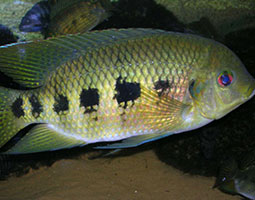Tilapia mariae
Description

Spotted tilapia are a deep-bodied, oval fish with a thin profile and 8-9 dark spots or bands on the side of their bodies, although this is more obvious on juveniles. They can grow to lengths of 30 cm and be sexual mature at 11cm. Their colouration can vary from dark olive-green to pale yellow, and some individuals even have a splash of pink. Adult fish may have red edges on their long tapered fins and red blushing on their bodies. These fish, like a number of tilapia species, can tolerate slightly saline water and have a quick growth and reproduction rate.
Spawning in this species is believed to occur from spring to autumn where they will congregate together as they prefer spawning in colonies. Spotted tilapia pair-bond well before spawning and remain together to raise their offspring. Female tilapia lay approximately 300 turquoise eggs, 1.8mm in diameter, on a hard substrate typically beneath clean gravel, debris or rocks which they adhere to. The female will then return to the rock after 2 days and remove all fertile eggs to a nearby pit where they will hatch and both parents will protect them until they are independent at approximately 9 days old.
Spotted tilapia are found naturally in Western Africa, but have become established in Australia where they have become an invasive species. They inhabit a diverse range of still or slow flowing, warm waters and are most common in small creeks or the lower parts of rivers. Within these habitats they can be found near structures such as vegetated banks and rocky outcrops near sandy or muddy substrate in freshwater or brackish waterways.
Adaptations
- Consume any infertile eggs after fertile eggs have hatched to save energy
- Larvae can stick their heads onto rocks to prevent drifting away in the current
- Broad temperature and salinity tolerance ranges enable it to survive in wide ranging environments
- High reproductive rates and sexually mature at young age
Feeding relationships
- What I eat: aquatic plants, detritus, occasionally aquatic invertebrates
- What eats me: larger carnivorous fish, birds (e.g. Egret), crayfish, turtles
Interesting facts
Spotted tilapia will breed to the point that they dominate any habitat they are successfully introduced to. They out-compete native species and are so aggressive and territorial that they cause a decrease in the local biodiversity.